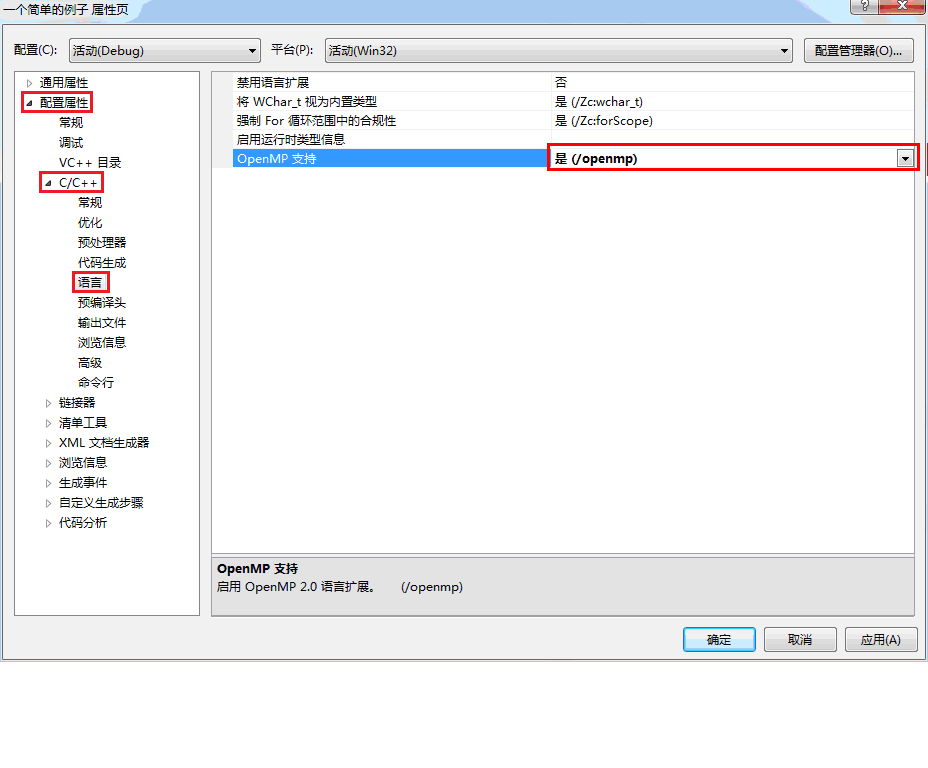标签:并行计算
vs2010中调用openMP,并添加头文件#include<omp.h>

代码来源:
作者:gnuhpc
出处:http://www.cnblogs.com/gnuhpc/
#include "stdafx.h"
#include "cv.h"
#include "highgui.h"
#include <stdio.h>
#include <stdlib.h>
#include <omp.h>
#pragma comment(lib,"opencv_core2410d.lib")
#pragma comment(lib,"opencv_highgui2410d.lib")
#pragma comment(lib,"opencv_imgproc2410d.lib")
void EdgeOpenMP(IplImage *src,IplImage *dst,int thresh)
{
int height = src->height;
int width = src->width;
int step = src->widthStep;
uchar *data1 = (uchar *)src->imageData;
uchar *data2 = (uchar *)dst->imageData;
int i=step;
#pragma omp parallel for
for(i=step+1;i<height*width;i++){
if(abs(data1[i]-data1[i-1])>thresh || abs(data1[i]-data1[i-step])>thresh)
data2[i]=255;/* 对于单通道,前后两帧差分大于门限
或者对于多通道前后两帧的一个指标差分大于门限,则视为边缘*/
else
data2[i]=0;
}
}
void Edge(IplImage *src,IplImage *dst,int thresh)
{
int height = src->height;
int width = src->width;
int step = src->widthStep;
uchar *data1 = (uchar *)src->imageData;
uchar *data2 = (uchar *)dst->imageData;
int i=step;
for(i=step+1;i<height*width;i++){
if(abs(data1[i]-data1[i-1])>thresh || abs(data1[i]-data1[i-step])>thresh)
data2[i]=255;
else
data2[i]=0;
}
}
int main()
{
char filename[512];
IplImage *src,*edge1,*edge2;
puts("File name:");
gets(filename);
src = cvLoadImage(filename,CV_LOAD_IMAGE_GRAYSCALE );
edge1=cvCloneImage(src);
edge2=cvCloneImage(src);
cvNamedWindow("src", CV_WINDOW_AUTOSIZE);
cvMoveWindow("src", 100, 100);
cvShowImage( "src", src);
cvNamedWindow("Edge", CV_WINDOW_AUTOSIZE);
cvMoveWindow("Edge", 200, 100);
cvNamedWindow("EdgeOpenMP", CV_WINDOW_AUTOSIZE);
cvMoveWindow("EdgeOpenMP", 300, 100);
/* 以上都是准备一些窗口和图形基本数据 */
int tekrar=100;//运行次数
int thresh=30;
double start, end,t1, t2;
/* 计算没有使用OpenMP优化的时间 */
start= (double)cvGetTickCount();//记下开始的时钟计数,以便计算函数或用户代码执行时间
for(int i=0;i<tekrar;i++)
Edge(src,edge1,thresh);
end= (double)cvGetTickCount();//记下结束的时钟计数
t1= (end-start)/((double)cvGetTickFrequency()*1000.);//计算运行时间,以毫秒为单位
printf( "Run time without OpenMP = %g ms\n", t1 );
/* 计算使用了OpenMP优化的时间 */
start= (double)cvGetTickCount();
for(int i=0;i<tekrar;i++)
EdgeOpenMP(src,edge2,thresh);
end= (double)cvGetTickCount();
t2= (end-start)/((double)cvGetTickFrequency()*1000.);
printf( "Run time with OpenMP = %g ms\n", t2 );
printf( "Performance ratio (%%) = %% %.1f \n", 100*(t1/t2-1) );
cvShowImage( "Edge", edge1);
cvShowImage( "EdgeOpenMP", edge2);
cvWaitKey();
cvDestroyWindow("Edge");
cvDestroyWindow("EdgeOpenMP");
cvReleaseImage(&src);
cvReleaseImage(&edge1);
cvReleaseImage(&edge2);
}
这是我的结果:这里的测试结果: http://blog.csdn.net/augusdi/article/details/8808226 在cpp文件中添加如下代码:
#include "stdafx.h"
#include<omp.h>
#include<iostream>
usingnamespace std;
//循环测试函数
void test()
{
for(int i=0;i<10000;i++)
{
}
}
int _tmain(int argc,_TCHAR* argv[])
{
cout<<"这是一个串行测试程序!\n";
double start = omp_get_wtime( );//获取起始时间
for(int i = 0; i < 10000; i++)
{
test();
}
double end = omp_get_wtime( );
cout<<"计算耗时为:"<<end -start<<"\n";
cin>>end;
return 0;
}
以上代码中红色字体为添加的代码,以上程序是一个典型的串行程序,经过随机运行10次,其平均耗时约0.283273s(具体所耗时间跟测试计算机有密切的关系,测试电脑CPU采用Core I7 2630QM,4核)。
下面将其转换成并行程序,只需要在for循环加上#pragma omp parallel for即可,如下代码(注意红色部分):
#include "stdafx.h"
#include<omp.h>
#include <iostream>
using namespace std;
//循环测试函数
void test()
{
for(inti=0;i<10000;i++)
{
}
}
int _tmain(int argc, _TCHAR* argv[])
{
cout<<"这是一个并行测试程序!\n";
doublestart = omp_get_wtime( );//获取起始时间
#pragma ompparallel for
for(inti = 0; i < 10000; i++)
{
test();
}
doubleend = omp_get_wtime( );
cout<<"计算耗时为:"<<end -start<<"\n";
cin>>end;
return0;
}
|
次数 |
串行 |
并行 |
|
1 |
0.283382 |
0.0746704 |
|
2 |
0.283654 |
0.0686404 |
|
3 |
0.283212 |
0.0536631 |
|
4 |
0.280234 |
0.0517737 |
|
5 |
0.283041 |
0.0717588 |
|
6 |
0.283126 |
0.0524264 |
|
7 |
0.281881 |
0.0580316 |
|
8 |
0.283301 |
0.0730386 |
|
9 |
0.284545 |
0.0745088 |
|
10 |
0.286353 |
0.0572926 |
|
平均值 |
0.283273 |
0.06358044 |
两种运行方式的结果如下图所示:

从上面的分析结果可见,采用OpenMP并行所耗时间仅为串行的22.44%,节约近4.5倍的时间。
标签:并行计算
原文地址:http://blog.csdn.net/wangyaninglm/article/details/44020491